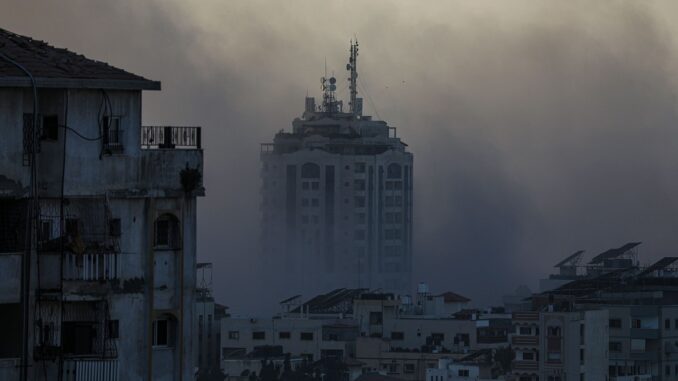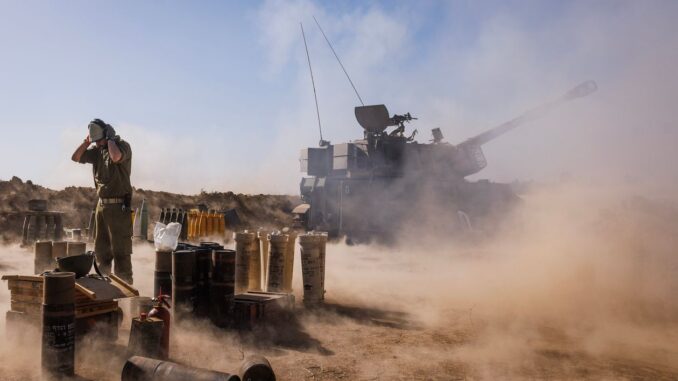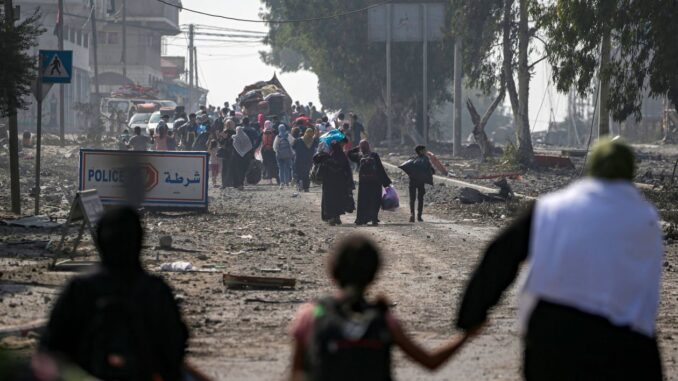Israel says much of Hamas’s military defenses, its command and many fighters are concentrated in Gaza City
By David S. Cloud, and Dov Lieber, WSJ Nov. 6, 2023 5:45 pm ET

TEL AVIV—Israel pushed further into Gaza City, sending troops into an urban Hamas stronghold that is still packed with civilians after one of the most intense bombing barrages of the monthlong war.
Israeli military spokesman Rear Admiral Daniel Hagari said that Israeli forces “are continuing to deepen the pressure into the depths of Gaza City.” He didn’t say during a briefing Monday where Israeli soldiers are operating, and Israeli officials have been careful not to disclose the location of their ground forces in Gaza.
Hagari said that the engineering corps is focusing on destroying Hamas’s tunnels wherever they find exit points, some of which he said are near civilian structures such as hospitals and schools. He said the Israeli military continues to focus on killing Hamas’s commanders in the field.
“The elimination of Hamas’s ground command has a significant impact on Hamas’s ability to mount counter strikes,” he said.
Israeli forces were making a push southward along the coast toward the densely populated Al-Shati Camp, which was hit hard Sunday night by Israeli airstrikes, said Michael Horowitz, the Israel-based head of intelligence for the consulting firm Le Beck. Horowitz said the troops seemed to be working methodically to clear out Hamas tunnels on the perimeter of the city before moving deeper. Horowitz said he saw no evidence to place Israeli soldiers in the heart of Gaza City at the moment.
Israel’s ground operations around Gaza City were accompanied by continued strikes, with the military saying Monday that its jet fighters had struck around 450 targets over the previous 24 hours. The targeted sites included Hamas military compounds, observation posts and firing positions for antitank missiles, the military said. Navy warships positioned in the Mediterranean Sea had also bombarded Hamas facilities, the military said.
The latest push coincided with a third communications blackout in the enclave, with phone and internet services cut off from the Israeli side on Sunday and only gradually restored on Monday, according to Paltel, the telecommunications company that services Gaza.
Israeli officials didn’t respond to a request for comment on the communications blackout. Aid agencies say such blackouts disrupt emergency services, including calls to ambulances, and prevent Gaza residents from checking on family members amid the bombardments.
Hamas used mortars to attack Israeli troops entering Gaza City from the northwest and south, the group, deemed a terrorist organization by the U.S., said on its Telegram channel. It later posted on the same channel that it had bombed “a dismounted infantry force” in “the Al-Maqousi area in Gaza City with dozens of mortar shells.”
A senior Israeli security official said the military’s goal was to destroy Hamas’s command structure in Gaza City. But doing so will require difficult decisions about whether to strike hospitals and other civilian structures and about fighting inside an underground tunnel system where Israel contends many of Hamas’s senior members—and possibly hostages taken by Palestinian militants—are located.
The senior security official said that once the military had taken out Hamas’s commanders, the group’s rank and file would pose less of a threat and could be defeated as the conflict evolves from the heavy-combat phase to one of lower intensity.
Although some Israeli officials believe that the defeat of Hamas could take as long as a year, the senior security official said there is concern in the military that Israeli Prime Minister Benjamin Netanyahu’s government is likely to face growing pressure even from the U.S. to curtail combat before its war aims are accomplished.
Gaza residents and doctors said airstrikes also hit close to Al-Shifa Hospital, Gaza’s largest hospital, where, in addition to patients, thousands of civilians have been sheltering, and a crowded refugee camp in the north of the enclave. Israeli military commanders have said in recent days that Hamas has put command facilities, ammunition stockpiles and firing positions near and underneath hospitals, which Hamas has denied.

An Israeli unit in southern Israel fires toward the Gaza Strip. PHOTO: DAN KITWOOD/GETTY IMAGES
Since Hamas’s Oct. 7 attacks, in which the group’s fighters killed some 1,400 people inside Israel, the Israeli military has carried out thousands of airstrikes in Gaza, bringing down high rises, transforming neighborhood blocks into rubble and prompting more than half of the strip’s 2.2 million residents to flee their homes.
The Hamas-controlled health authorities in Gaza said Monday that more than 10,000 Palestinians had been killed in the month-old war, the majority of whom are women and children. The figures don’t distinguish between civilians and combatants. Israel said 31 soldiers have been killed since it launched the ground war in Gaza on Oct. 27.
President Biden spoke Monday morning with Netanyahu, the White House said, a conversation that included discussion of “the possibility of tactical pauses to provide civilians with opportunities to safely depart from areas of ongoing fighting, to ensure assistance is reaching civilians in need, and to enable potential hostage releases.”
The two also discussed efforts to secure the release of hostages and humanitarian assistance for Gaza. The White House said Biden “reiterated his steadfast support for Israel and the protection of Israeli citizens from Hamas and all other threats while also emphasizing the imperative to protect Palestinian civilians and reduce civilian harm in the course of military operations.”
Netanyahu has resisted pressure from the U.S. to pause Israeli airstrikes to facilitate humanitarian-aid deliveries unless an estimated 241 hostages taken by Hamas fighters from Israel are released. Netanyahu has also dismissed calls for a broader cease-fire from the United Nations and increasingly alarmed Arab countries, including Jordan and Egypt, which made peace with it decades ago.

More than half of the Gaza Strip’s 2.2 million residents have fled their homes. PHOTO: MOHAMMED SABER/SHUTTERSTOCK
Inside Gaza City, Israeli forces will likely face Hamas militants who have barricaded themselves inside bombed-out buildings and built a network of tunnels and underground command bunkers. Many civilians remain in the city and its surrounding neighborhoods, unable or afraid to leave the north because of the fighting, despite repeated Israeli calls for noncombatants to move south.
Amid Israel’s intensifying offensive, scores of residents of northern Gaza on Monday took advantage of a corridor opened by the Israeli military to flee to the south of the strip. The Israeli military said the corridor would be open for around four hours.
Witnesses said Israeli tanks and roadblocks were positioned in the area of the corridor around Salah Al-Din Street, a major thoroughfare in Gaza. Some residents said Israeli soldiers were photographing and searching people, preventing the entry of some personal belongings onto the corridor and arresting people.
Israeli military spokesman Lt. Col. Richard Hecht said the military had established roadblocks both to keep the corridor open and prevent Hamas’s militants from going south.
The Israeli security official said the Israeli military had already destroyed large portions of the two Hamas brigades that are defending Gaza City. Hamas’s armed wing has an estimated 30,000 to 40,000 fighters, divided into six brigades, the official said, declining to provide casualty estimates.
On Monday, an Israeli government spokesman said one of its airstrikes had killed Wael Asefa, a Hamas commander who was “personally responsible” for ordering the Oct. 7 attacks.
As Israeli troops have drawn closer to Gaza City, Hamas fighters have used the tunnel system to ambush them, the official said.
Ghassan Abu-Sittah, a surgeon working at Al-Shifa Hospital in Gaza City, said Monday that bombing was especially intense in the vicinity of the hospital. Israeli officials have said that Hamas uses the hospital as one of its main command centers for carrying out militant operations.
Abu-Sittah said the hospital had received a large number of dead from the Al-Shati refugee camp in northern Gaza, which he said was also struck in the Israeli bombardment. “It was horrendous,” he said.
Hecht said Shati was a “terrorist stronghold,” but declined to comment on the reported mass casualties there resulting from Israeli strikes.
Chao Deng, Anas Baba, Omar Abdel-Baqui and Catherine Lucey contributed to this article.
Write to David S. Cloud at david.cloud@wsj.com and Dov Lieber at dov.lieber@wsj.com



Leave a Reply
You must be logged in to post a comment.